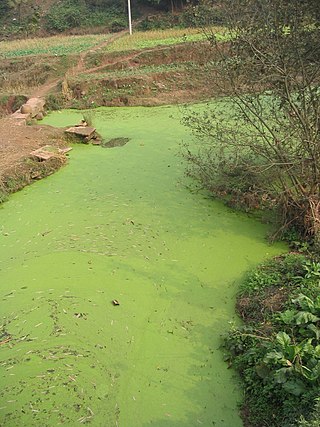
Eutrophication is the "explosive growth of microorganisms, to the extent that dissolved oxygen is depleted". Other definitions emphasize the role of excessive nutrient supply: "excessive plant growth resulting from nutrient enrichment". and phosphorus. It has also been defined as "nutrient-induced increase in phytoplankton productivity".

Limnology is the study of inland aquatic ecosystems. The study of limnology includes aspects of the biological, chemical, physical, and geological characteristics of fresh and saline, natural and man-made bodies of water. This includes the study of lakes, reservoirs, ponds, rivers, springs, streams, wetlands, and groundwater. Water systems are often categorized as either running (lotic) or standing (lentic).
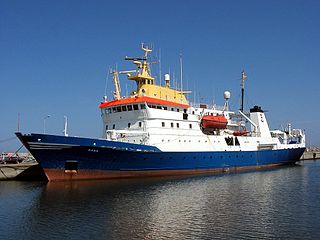
Fisheries science is the academic discipline of managing and understanding fisheries. It is a multidisciplinary science, which draws on the disciplines of limnology, oceanography, freshwater biology, marine biology, meteorology, conservation, ecology, population dynamics, economics, statistics, decision analysis, management, and many others in an attempt to provide an integrated picture of fisheries. In some cases new disciplines have emerged, as in the case of bioeconomics and fisheries law. Because fisheries science is such an all-encompassing field, fisheries scientists often use methods from a broad array of academic disciplines. Over the most recent several decades, there have been declines in fish stocks (populations) in many regions along with increasing concern about the impact of intensive fishing on marine and freshwater biodiversity.
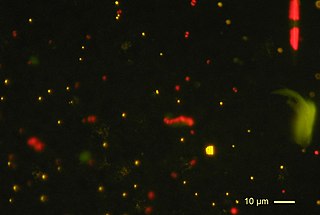
Picoplankton is the fraction of plankton composed by cells between 0.2 and 2 μm that can be either prokaryotic and eukaryotic phototrophs and heterotrophs:

Colored dissolved organic matter (CDOM) is the optically measurable component of dissolved organic matter in water. Also known as chromophoric dissolved organic matter, yellow substance, and gelbstoff, CDOM occurs naturally in aquatic environments and is a complex mixture of many hundreds to thousands of individual, unique organic matter molecules, which are primarily leached from decaying detritus and organic matter. CDOM most strongly absorbs short wavelength light ranging from blue to ultraviolet, whereas pure water absorbs longer wavelength red light. Therefore, water with little or no CDOM, such as the open ocean, appears blue. Waters containing high amounts of CDOM can range from brown, as in many rivers, to yellow and yellow-brown in coastal waters. In general, CDOM concentrations are much higher in fresh waters and estuaries than in the open ocean, though concentrations are highly variable, as is the estimated contribution of CDOM to the total dissolved organic matter pool.

Bithynia tentaculata, common names the mud bithynia or common bithynia, or faucet snail is a relatively small species of freshwater snail with gills and an operculum, an aquatic prosobranch gastropod mollusk in the family Bithyniidae.
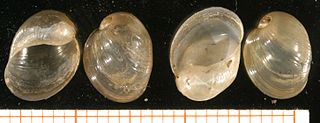
Myxas glutinosa is a species of small air-breathing freshwater snail, an aquatic gastropod mollusc in the family Lymnaeidae, the pond snails.

The Trophic State Index (TSI) is a classification system designed to rate water bodies based on the amount of biological productivity they sustain. Although the term "trophic index" is commonly applied to lakes, any surface water body may be indexed.

The nuchal organ is a ciliated pit or groove present at the posterior end of the prostomium of annelid worms, some cephalopods, and other invertebrates.
Landscape limnology is the spatially explicit study of lakes, streams, and wetlands as they interact with freshwater, terrestrial, and human landscapes to determine the effects of pattern on ecosystem processes across temporal and spatial scales. Limnology is the study of inland water bodies inclusive of rivers, lakes, and wetlands; landscape limnology seeks to integrate all of these ecosystem types.

Hydrobiologia, The International Journal of Aquatic Sciences, is a peer-reviewed scientific journal publishing 21 issues per year, for a total of well over 4000 pages per year. Hydrobiologia publishes original research, reviews and opinions investigating the biology of freshwater and marine habitats, including the impact of human activities. Coverage includes molecular-, organism-, community -and ecosystem-level studies dealing with biological research in limnology and oceanography, including systematics and aquatic ecology. In addition to hypothesis-driven experimental research, it presents theoretical papers relevant to a broad hydrobiological audience, and collections of papers in special issues covering focused topics.

Echiniscus testudo is a cosmopolitan species of tardigrade.
IISD Experimental Lakes Area is an internationally unique research station encompassing 58 formerly pristine freshwater lakes in Kenora District, Ontario, Canada. In response to the International Joint Commission (IJC)'s 1965 recommendations related to transboundary pollution, the federal and provincial governments set aside these lakes to study water pollution. During the 1970s and 1980s, David Schindler, who was at that time 'Canada's leading ecologist', conducted a series of innovative, landmark large-scale experiments in ELA on eutrophication that led to the banning of phosphates in detergents. In an unexpected and controversial move that was widely condemned by the scientific community, in 2012 the ELA was de-funded by the Canadian Federal Government. The facility is now managed and operated by the International Institute for Sustainable Development (IISD) and has a mandate to investigate the aquatic effects of a wide variety of stresses on lakes and their catchments. IISD-ELA used the whole ecosystem approach and makes long-term, whole-lake investigations of freshwater focusing on eutrophication.

A soda lake or alkaline lake is a lake on the strongly alkaline side of neutrality, typically with a pH value between 9 and 12. They are characterized by high concentrations of carbonate salts, typically sodium carbonate, giving rise to their alkalinity. In addition, many soda lakes also contain high concentrations of sodium chloride and other dissolved salts, making them saline or hypersaline lakes as well. High pH and salinity often coincide, because of how soda lakes develop. The resulting hypersaline and highly alkalic soda lakes are considered some of the most extreme aquatic environments on Earth.

Stephen Russell Carpenter is an American lake ecologist who focuses on lake eutrophication which is the over-enrichment of lake ecosystems leading to toxic blooms of micro-organisms and fish kills.

Sinotaia aeruginosa is a species of freshwater snail with a gill and an operculum, an aquatic gastropod mollusk in the family Viviparidae. It is widely distributed and common species in China and in northern Vietnam inhabiting various shallow freshwater habitats, where it can reach high densities. It is a keystone species in its habitat and can significantly affect water quality and phytoplankton communities. It is commonly used in Chinese cuisine.

Erin Hotchkiss is an ecologist who studies climate change's specific impact on freshwater ecosystems. She researches the relationships between organisms and water quality in freshwater ecosystems, how processes on land influence water, and the sources and fate of carbon and nutrients in aquatic ecosystems. Hotchkiss is currently an Assistant Professor in the Department of Biological Studies at Virginia Polytechnic Institute and State University.

The shoreline development index of a lake is the ratio of the length of the lake's shoreline to the circumference of a circle with the same area as the lake. It is given in equation form as , where is shoreline development, is the length of the lake's shoreline, and is the lake's area. The length and area should be measured in the units. The shoreline development index is for perfectly circular lakes. for lakes with complex shapes.
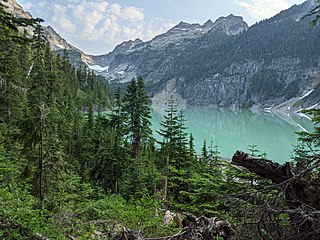
An alpine lake is a high-altitude lake in a mountainous area, usually near or above the tree line, with extended periods of ice cover. These lakes are commonly glacial lakes formed from glacial activity but can also be formed from geological processes such as volcanic activity or landslides. Many alpine lakes that are fed from glacial meltwater have the characteristic bright turquoise green color as a result of glacial flour, suspended minerals derived from a glacier scouring the bedrock. When active glaciers are not supplying water to the lake, such as a majority of Rocky Mountains alpine lakes in the United States, the lakes may still be bright blue due to the lack of algal growth resulting from cold temperatures, lack of nutrient run-off from surrounding land, and lack of sediment input. The coloration and mountain locations of alpine lakes attract lots of recreational activity.

Water clarity is a descriptive term for how deeply visible light penetrates through water. In addition to light penetration, the term water clarity is also often used to describe underwater visibility. Water clarity is one way that humans measure water quality, along with oxygen concentration and the presence or absence of pollutants and algal blooms.

















